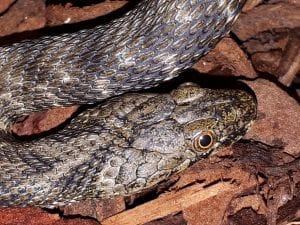Dice snakes (Natrix tessellata) are a harmless European water snake widely distributed throughout Europe, North African and the Middle East. As it is a water snake, its primary habitat is around ponds, slow moving streams and lakes – but also found around human habitation such as irrigation channels and tanks. Although classified as harmless it’s reported to have a well developed gland in its mouth that produces a mild neurotoxin and produces a potent antihemorrhagin in its serum. However this is highly unlikely to effect humans. They also void the contents of their vent, which is a smelly defence.
This species when I was a child, was a common pet snake – along with the related Grass and Viperine snakes. I remember visiting pet shops where a tank would be full of all three species – heavily over crowded in dire conditions. Thankfully the modern industry has changed over the years. This species is now hard to come by in captivity, and the conditions it requires to keep successfully is well understood.
A secure vivarium, preferably of glass construction, of around a meter in length is ideal to keep this species. They are opportunistic climbers, so height is advisable – maybe 60cm or so tall. Lighting should be full spectrum, with a lower level of UVB – maybe a T5 fluorescent tube with around 6{cb5d0a8cf0c44aef2db327d9ab0dba08dd09aed1126b509e5fa01d3aaa87fe47} UVB output. Heating should be overhead, as this snake likes to bask – this can be the preferred choice, some keepers like to use halogen, others prefer ceramics and other forms. All have pro’s and con’s – my own preference is using a ceramic. A day time temperature of around 28C under the basking source is ideal. Ensure a thermostat is used to safely control the temperature.
These snakes are a water loving species, and they do naturally swim in the wild. However in a vivarium they are prone to skin problems if they are kept too wet. They must have the ability to thoroughly dry out in the vivarium if a large water source is provided. They also need hides, climbing branches and many keepers like to provide naturalistic style terraria.
Food, in the wild is fish and amphibians – there are notes of rodents and other prey items also been taken. In captivity the best source of food is fish.
